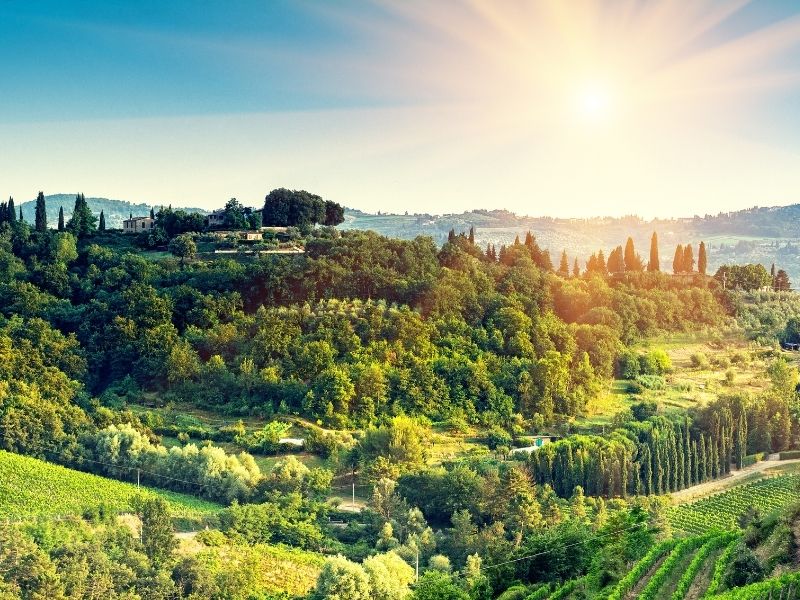The Chianti area is the ideal place for trips through medieval alleys, romantic vineyards and characteristic hilly landscapes. In each of the small villages that dot this area, you can come across wineries, castles and farms, as well as taste the local products in the many wine bars that line the streets. The origins, rich in a legendary history, the beauty of this land and the wine-making tradition have made Chianti famous the world over.
DIFFERENCE BETWEEN CHIANTI AND CHIANTI CLASSICO
For those who travel to these lands, the real guide to the knowledge of the territory are the flavours, the tastes of a land that act as the supporting frame for the local culture. Prince of tradition, is certainly the wine. Chianti Classico has a history that dates back over the centuries, with nomenclatures, rules of cultivation and extremely strict care of the land.
Specifically, Chianti Classico DOCG is the denomination reserved for red wines in the oldest area of Chianti, the one between the provinces of Florence and Siena, composed of the municipalities of Greve in Chianti, Castellina in Chianti, Radda in Chianti, Gaiole in Chianti, San Casciano val di Pesa and Tavarnelle.
PRODUCTION AREA
The Chianti Classico production area was the first in the world to be defined by law, with a decree in 1716 by the Grand Duke of Tuscany Cosimo III, which delimited the boundaries within which Chianti wines could be produced, thus establishing the first “Consortium”: a congregation to supervise wine production and trade to protect against fraud.
A LOOK AT HISTORY
Throughout the 1700s, Chianti was produced using only the grapes of the Sangiovese grape variety, a grape very sensitive to external factors that has the ability to change its aromas depending on the soil in which it is grown.
Only in 1800, by Baron Bettino Ricasoli, the practice of mixing different varieties of grapes was born, with the aim of improving the quality and taste of production.
GRAPE VARIETIES ALLOWED BY THE REGULATION TO PRODUCE CHIANTI CLASSICO DOCG
The Regulation of Chianti Classico DOCG, about the grape varieties allowed, reads:
- Sangiovese, from 80% up to 100%.
- Red grapes from “suitable grape varieties” for cultivation in the Tuscany region can also contribute to the production, to the maximum extent of 20%. The “suitable grape varieties” are many, but traditionally the complementary grape varieties used are, in addition to the “king” Sangiovese, the native Canaiolo and Colorino or the international Cabernet Sauvignon and Merlot.
PRODUCTION TECHNIQUES OF CHIANTI CLASSICO DOCG
To produce Chianti Classico DOCG, only vineyards on hilly areas are suitable, whose soils, located at an altitude not exceeding 700 metres, consist mainly of sandstone, marly calcareous substrates, clay shale, sands and pebbles. On the other hand, vineyards located in humid soils, on valley bottoms and strongly clayey are to be considered unsuitable. Any form of vine growing on a pergola is prohibited.
ORGANOLEPTIC CHARACTERISTICS OF CHIANTI CLASSICO DOCG
- Colour: intense and deep ruby;
- Scent: floral notes combined with a typical character of red fruits. Fine spicy and balsamic notes in some reserves and selections;
- Flavour: harmonious, dry, intense and sapid.
Sangiovese manages to have its best performance only in a few areas of Tuscany. The climate and the morphology of the soils of these areas determine a sunny environment particularly suitable for the correct ripening of the grapes. The summer temperatures allow the latter to mature slowly and completely, determining the organoleptic and chemical characteristics, typical of Chianti Classico: the colour, the bouquet and the alcohol content.
In conclusion, if you are looking for a noteworthy native experience, a delicious tasting of Chianti wines will certainly make your holiday in Tuscany one-of-a-kind.








